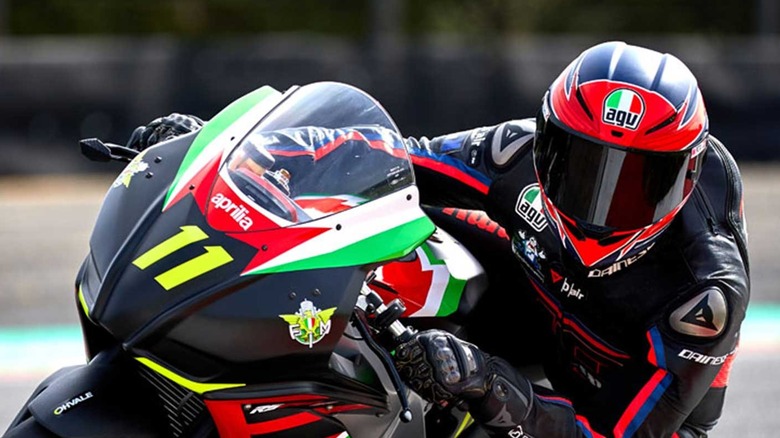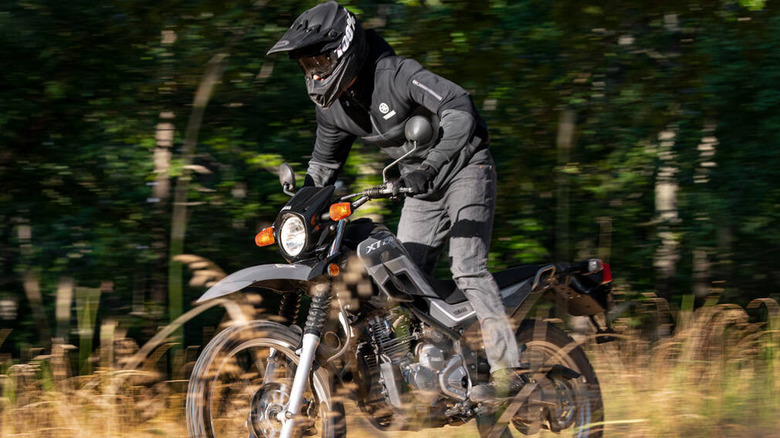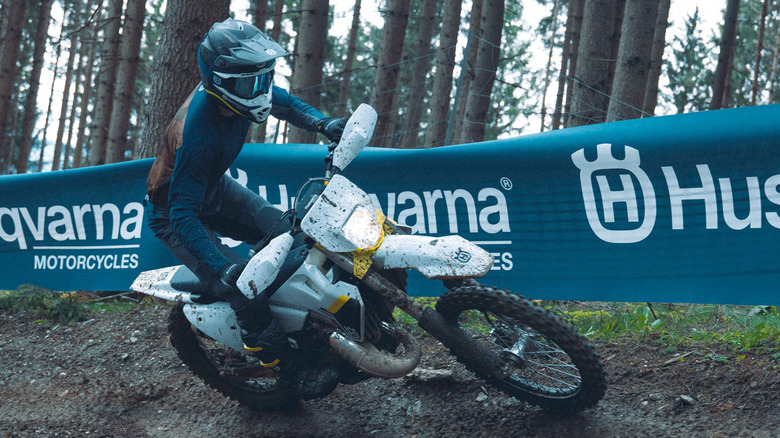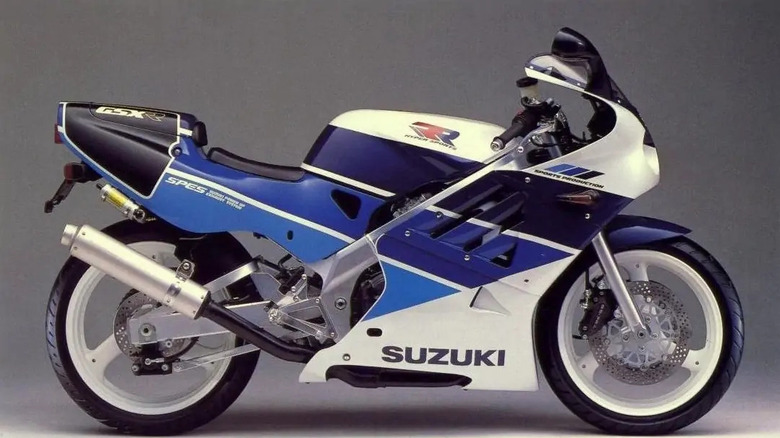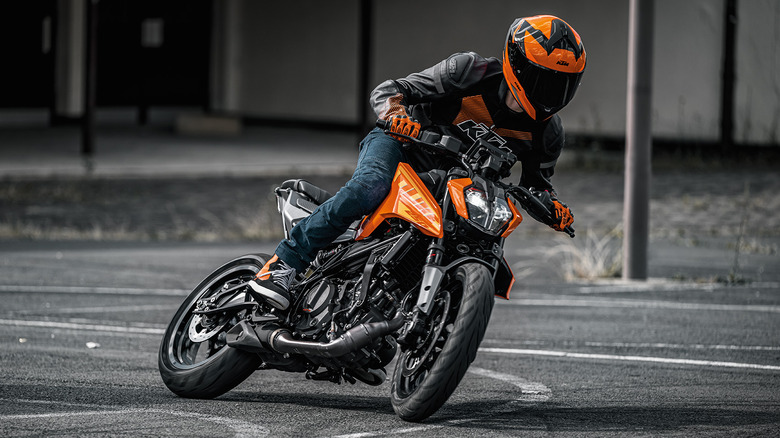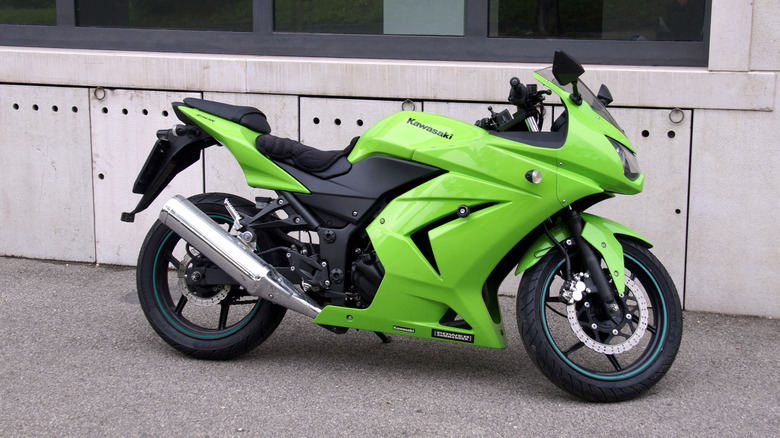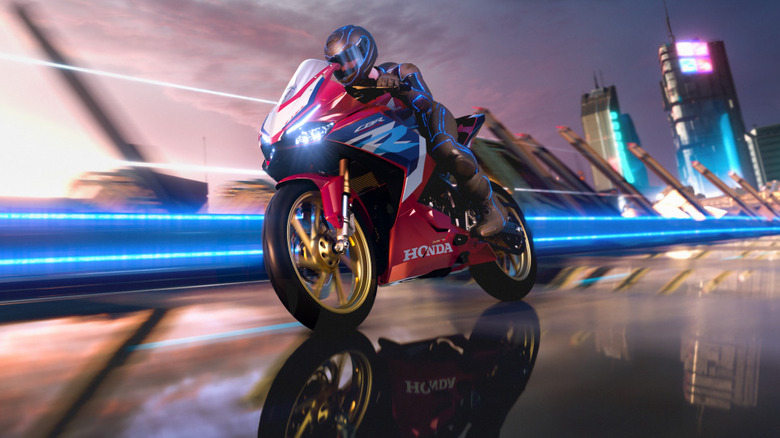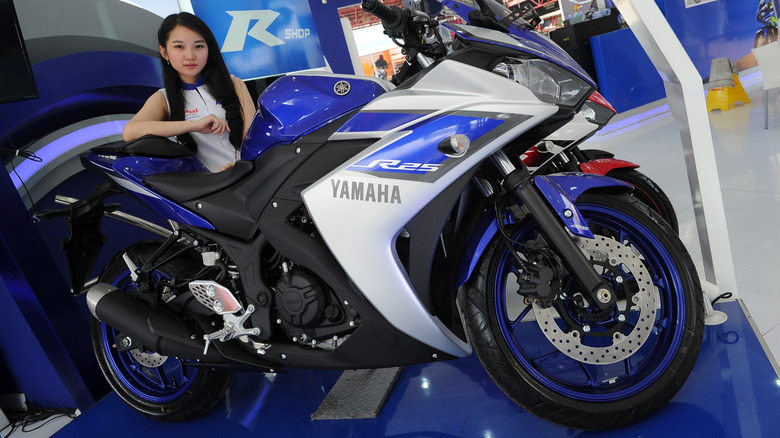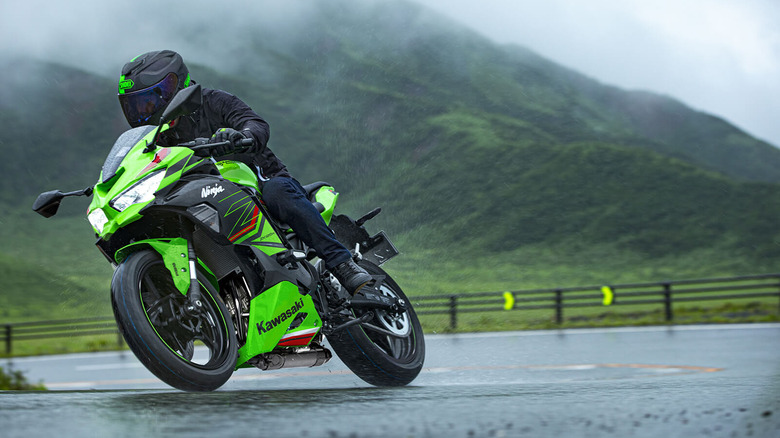Nine Of The Fastest Motorcycles Under 250cc, Ranked By Top Speed
In the bike community, it's a rule of thumb that you should start with a small engine and work your way up to a bigger one. Thus, motorcycles with a sub-250 cubic centimeter (cc) displacement seem to be in the Goldilocks zone for beginner riders. That said, experienced riders will also no doubt enjoy having these pocket-rocket machines in the garage for a city runabout. However, don't let the quarter-liter engine size fool you — all of the bikes on this list are race-bred, at least in their engineering. Whether you full send them or use them as mall-crawler mopeds is up to you. They're certainly great fun in both scenarios, and everything in between.
Note that several motocross (dirt) bikes do indeed have engines under 250cc, but we wanted to focus mostly on motorcycles that were intended to be more road-going. However, we have included one motocross bike — the Husqvarna TE250. Also, while custom bikes are popular among enthusiasts, to make it onto our list, the bikes had to be production units only. Also, the top speeds must be verifiable with no mods and stock gearing, with the factory rev limiters engaged. Here are nine of the fastest motorcycles with engines under 250cc, ranked by top speed.
9. Yamaha XT250 - 70 mph
The XT250 celebrates its 45th anniversary in 2025, having been launched way back in 1980 as a trail-slash-off-road bike. It was actually Yamaha's first four-stroke 250cc dual-purpose offering, and is fondly nicknamed the Serow. When it was introduced, the XT250 came with a monocross suspension while the rest of the class was still very much using twin shocks as the standard. This made the XT250 somewhat of an outlier in the 250cc trail bike class, but it eventually became popular among many different riding subgroups, from dirt-biking to woods-riding, and even enduro racing. Hollywood enthusiasts will be interested to learn that the XT250 was Sylvester Stallone's bike of choice in the 1982 film Rambo, in which he used it to pop a wheelie, jump over a railroad crossing, and disappear up a mountain. The XT250 has, as of 2020, been discontinued in many markets around the world, but continues to be available in the States, with prices starting at $5,499.
The current model features a 249cc, single-cylinder four-stroke engine and has all the bits and bobs you'd expect a top-tier enduro bike to have, such as front and rear disc brakes, a 2.5-gallon fuel tank, a five-speed multiplate wet clutch system, and a single shock absorber at the rear with adjustable preload. Though it may seem underpowered to some, it actually manages to get up to a top speed of 70 mph, so the next time you see a humble XT250 on the motorway, always remember that it was good enough for John Rambo.
8. Husqvarna TE 250 - 85 mph
Husqvarna claims the TE 250 is "the most competitive and versatile two-stroke enduro machine on the market". There's certainly some merit to this claim because Husqvarna absolutely dominated the motorcycle racing scene in the mid 1900s, racking up a total of 24 Enduro European title wins, 14 Motocross World Championship wins, and an unbelievable 11 Baja wins.
The current-generation TE 250 traces its roots back to the European 250cc Motocross Championship, which at the time was a four-month-long affair spanning thirteen rounds of arduous trail racing. In the 1950s, a total of 10 Husqvarna 250cc units were produced and given to the six best Swedes in the game, and, in 1958, Husqvarna had a particularly amazing season. The first major milestone that year was when Rolf Tibbin, then 22 years old, won his first championship in Germany on a Husqvarna 250cc. By the time the racing books for the year were closed, four out of the six Husqvarna 250 riders were among the top nine in the championship.
Of course, the Husky TE 250 of recent years has come a very long way since then, but since it is an Enduro class bike, it is still technically road legal. It has a top speed of 85 mph, comes with a 249cc, single-cylinder, two-stroke engine, factory-outfitted Brembo brakes, and a WP XACT monoshock suspension unit (rear). For those who plan to take it off the beaten track, it comes with an electric starter, wet DDS clutch with multiple discs, and nearly a foot (300 millimeters) of suspension travel at the front and rear.
7. Suzuki GSX-R250 - 85 mph
If you're familiar with motorcycles, then you'll have heard of the Suzuki GSX-R750, often referred to as the Gixxer 750. The R750 holds the U.S. record for most miles covered during a 24-hour race and has won 137 endurance races overall, out of which seven of those wins were in 24-hour races. Given the massive (and immediate) success of the R750, Suzuki followed up with a baby Gixxer, which they dubbed the GSX-R250. When launched, the R250 had a lot of the same technology as its more powerful siblings in the GSX-R lineup. It debuted with a box frame that was made of steel instead of aluminum, but still managed to keep weight low at 138 kg (304 pounds). It had a 248cc four-stroke, four-cylinder engine that managed to churn out an impressive 44.4 hp (45 PS) and 18.1 lb-ft of torque. As a result of being light and well-powered, the GSX-R250 could hit a top speed of 85 mph and had a six-speed constant-mesh transmission.
Two years down the line, Suzuki introduced the GSX-R250R, which now used an aluminum frame instead of steel. A modern ABS version of the GSX-R250R is available stateside for around $5,000, which is considered one of the most fuel-efficient motorcycles ever made. Alongside the R250R of 1989, Suzuki also launched the GSX-R250R-SP, which stood for sports production. This was essentially the ultimate trim, fully street-legal yet designed and intended for the track. It had only one seat, a fully adjustable front suspension, and was only available in the Suzuki racing livery of blue and white.
6. KTM Duke 250 - 85 mph
The first motorcycle on our list to break the 90 mph barrier is the KTM Duke 250, with its top speed of 95 miles per hour. Like many of the other bikes on our list, the Duke 250 is a minified version of its much larger, much more powerful siblings from the slightly bigger KTM Duke 390 all the way to the Super Duke 1390. It's been around for a while in other markets, but KTM motorcycles has only recently announced it for North America, and it made its debut stateside in 2024. The Duke 250 replaces the older Duke 200 series, and if you're interested, it is also offered in a 125cc model called the Duke 125.
As with most units in the Duke lineup, the Duke 250 is available either in ceramic white or electric orange liveries and is truly the definition of a pocket-rocket. The 2025 Duke 250 gets an updated 5-inch LCD multi-information display that lets you connect your phone, take calls, play music, and get turn-by-turn directions directly on screen. It has a two-piece construction, consisting of a steel frame coupled with an aluminum subframe, and, admittedly, lots of plastic throughout. However, details like that don't matter when this baby quarter-liter bike can hit 95 mph flat out, using a 249cc engine that produces only 30 hp.
5. Kawasaki Ninja 250R - 97.5 mph
Matching the Duke 250's top speed of 97.5 mph is the much older, equally impressive Ninja 250R, known affectionately as the baby Ninja. It probably should qualify for our list of the most underrated Kawasaki models ever made. This model came with a four-stroke dual overhead cam setup (DOHC) and a compression ratio of 11.6:1. The Ninja 250R had a curb weight (including 90% fuel and fluids) of 167 kg (368.1 pounds) and produced about 32 hp. Since the Ninja 250 was very clearly targeted at wet-behind-the-ears riders who didn't have much experience, Kawasaki included a nifty new feature at the time called an assist and slipper function clutch. What this did was basically, if you made an accidental downshift, something called a slipper hub would engage, and keep the clutch assembly and operating plate forcefully separated so you don't end up with a very expensive repair.
Kawasaki also included its Positive Neutral Finder (PNF) — a useful feature for beginner riders. If you were in first gear and wanted to find neutral, all you had to do was flick the shifter upwards once, and boom, you have neutral. This lets you avoid the unwanted situation of pulling the shift lever up too much, ending up in second gear instead of neutral, and then having to manage RPMs you hadn't planned for or wanted. All in all, the 250R is an amazing bike, and it's sad that it gets overlooked so often, but if you are on the lookout, you could snag one for about $3,000 these days.
4. Honda CBR250RR - 109 mph
Today, the CBR250RR has a bottom power baseline near the Ninja 250, but because of its twin cylinders, it makes peak power comparable to the Ninja 300. Also, the more recent models of the CBR250RR actually put out power comparable to the 300 series by Honda. Undoubtedly, the CBR250RR is one of, if not the, most important bikes on this list. At the time it was revealed, laws in Japan made the 250cc class the most important, and every major manufacturer had two-stroke 250cc models. But most also had high-revving, rather vocal four-stroke versions of those models. At that point, the only way to make more RPMs without adding more strokes and valves, or sending a piston into orbit, was to make the pistons smaller. This cycle continued until we got to the CBR250RR of modernity that produces 42 hp (31 kW) at 13,000 RPM, and rockets to a top speed of 109 mph.
Like the Ninja 250R, which was its main competitor, the CBR250RR also came with a slipper-assist clutch. You could tell that Honda was absolutely maxing out whatever they could within the category, as even the engine was only three-tenths of a cubic centimeter smaller than the 250cc limit. Unfortunately, none of the 250 models, other than some dirt bikes like the CRF line, were ever imported by Honda to the U.S., so finding an example worthy of upkeep would probably not cost less than five figures. Nonetheless, it's an impressive motorcycle that every enthusiast probably had on their bedroom wall at some point.
3. Yamaha YZF-R25 - 114 mph
Much to the disappointment of the community, Yamaha never actually brought the YZF-R25 to the U.S., though they did give the U.S. the R3 as consolation, which we compared to the Yamaha YZF-R15 earlier this year. One could argue that small bikes don't or won't do well in the U.S. because of our licensing process, as currently in all but 15 states, you can roll out of your license school, walk across the road, and scoop up an R1.
However, the fact remains that small bikes are extremely good fun, and not even having them on offer is a bit of a bummer. And for all those who claim that quarter-liter motorcycles can't be fast, we present the Yamaha R25. It comes with a four-stroke, dual-cylinder 249cc engine that's paired with a six-speed transmission that makes a grand total of 35 hp and 16.7 lb-ft of torque. All of that comes together in a package that weighs 169 kg (372.6 pounds), which means the R25 has a very respectable top speed of 114 mph.
2. Kawasaki Ninja ZX-25R - 118 mph
Ask any enthusiast, and the Ninja line will be among the first words mentioned when you say superbike. And while the relatively mini ZX-25R may not have the agility of a Ninja 650 or the oomph of a Ninja 1100 SX, it still has plenty to offer. Its engine is an inline-four cylinder with dual overhead cams, and it displaces exactly 250cc. This engine screams and roars to 15,500 RPM while pushing out 43.58 hp, and you can get one additional horsepower by using a feature called RAM air. RAM air systems use your momentum when on the road to increase the pressure inside the intake manifold to churn out a little more power. Kawasaki was actually the first manufacturer to slap a RAM air system on a bike (ZX-11, 1990), and to that end, the Ninja ZX-25R can climb up to a top speed of 118 mph, which is astounding from a quarter-liter bike.
The ZX-25R also churns out 16.23 lb-ft of torque (22 Nm) at 12,500 RPM, though it needs all that power and grunt as it weighs a not-insignificant 184 kg (405 pounds). We never got the ZX-25R or ZX-25RR stateside, and the nearest possible model we got was the 399cc ZX-4RR. There are so many great Kawasaki models that you can't buy in the U.S., and for better or worse, the ZX-25R is one of them. Even then, the ZX-4RR has a base MSRP of $9,499, at which point you could and should be considering other options.
1. Aprilia RS 250 SP - 138 mph
And now we come to the number one spot — the fastest motorcycle that we could find under 250cc — the Aprilia RS 250 SP. Despite having an engine displacement under a quarter-liter, the RS 250 SP manages to hit an eye-watering top speed of 138 miles per hour. In other parts of the world, the RS 250 SP is targeted at younger, novice riders, which is insane when you think about it. This is a 105 kg (231.4 pound) fully race-bred piece of Italian engineering from 1994 that can hit supercar speeds, and all that stands between you and hitting that speed is a full-cycle six-speed transmission. It has a 249.2cc, single-cylinder engine that produces 29.9 hp and 16.2 lb-ft of torque.
There's not much more to be said — it's under 250cc, is really, really fast, and is one of the best Aprilia motorcycles ever made. Just for reference, a 1995 Porsche 911 (993) Carrera boasted a top speed of 162 mph, which was just 24 mph faster than the RS 250 SP. But if you do want to feel the wind on your face while riding one of these, you'll have to import one, which would necessitate shelling out about $12,000, and that's not including sales fees, transport prep, or shipping. And that's it — the fastest motorcycles that we could find that have engines under 250 cubic centimeters. Though some of them were not available in the U.S., some are discontinued and no longer in production, some aren't even for the road — one can dream.
Methodology
Manufacturers' websites rarely list the top speeds of their motorcycles. We get all sorts of other information such as engine, bore, stroke, cooling, and everything in between. To find the top speed of the bikes on our list, we looked for real world test run videos online for each bike, ideally at least two per bike. If we found another online source to back up those numbers, we looked at that as well. If there was a mismatch between the online source and test run video, we used the video. We tried our best to look for videos that had a GPS speed verification as well, because speedometers usually have a margin of error, however this was not always feasible. Do remember that on the small quarter-liter engine class, the height, weight, and even riding position of the rider can make a huge difference.
